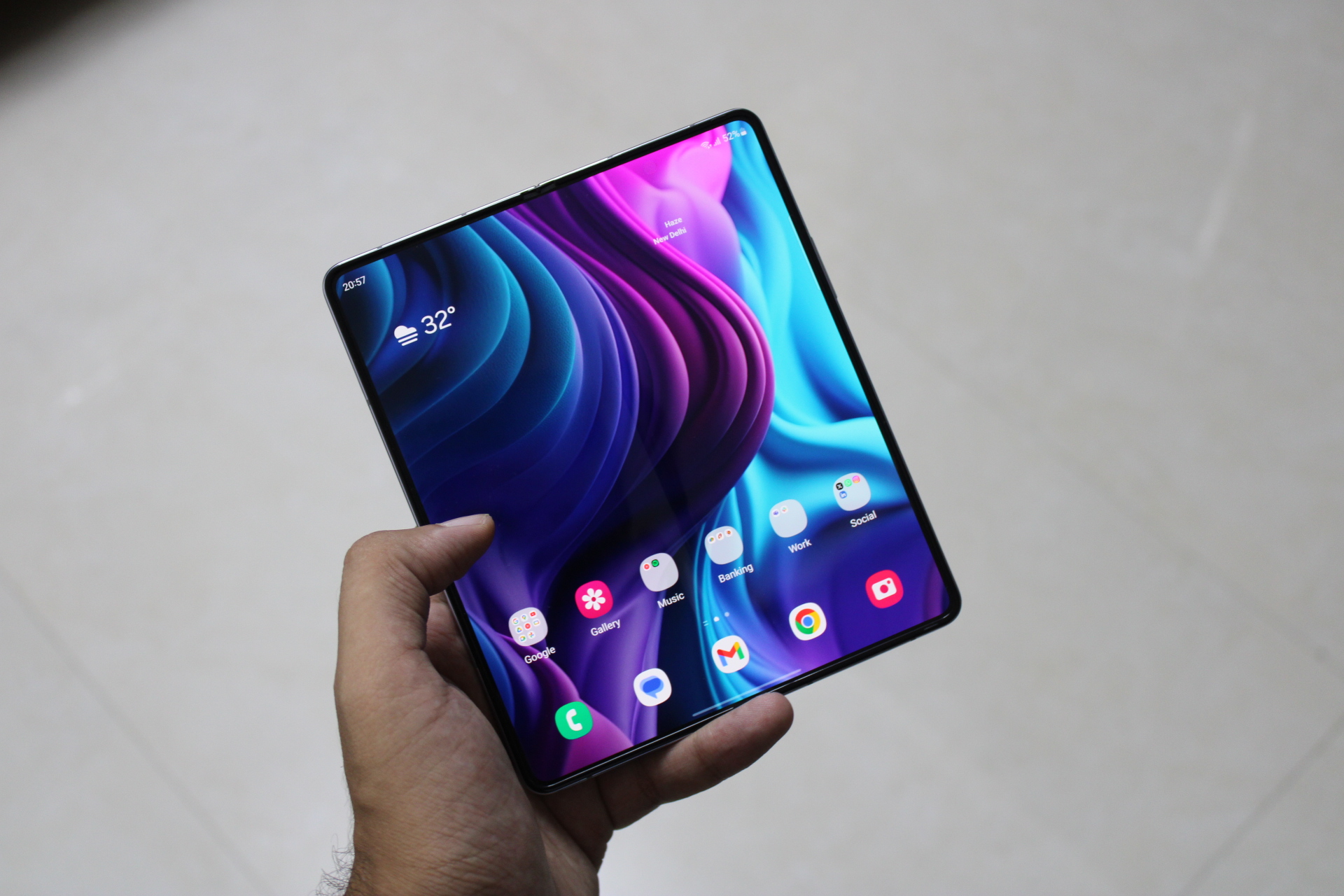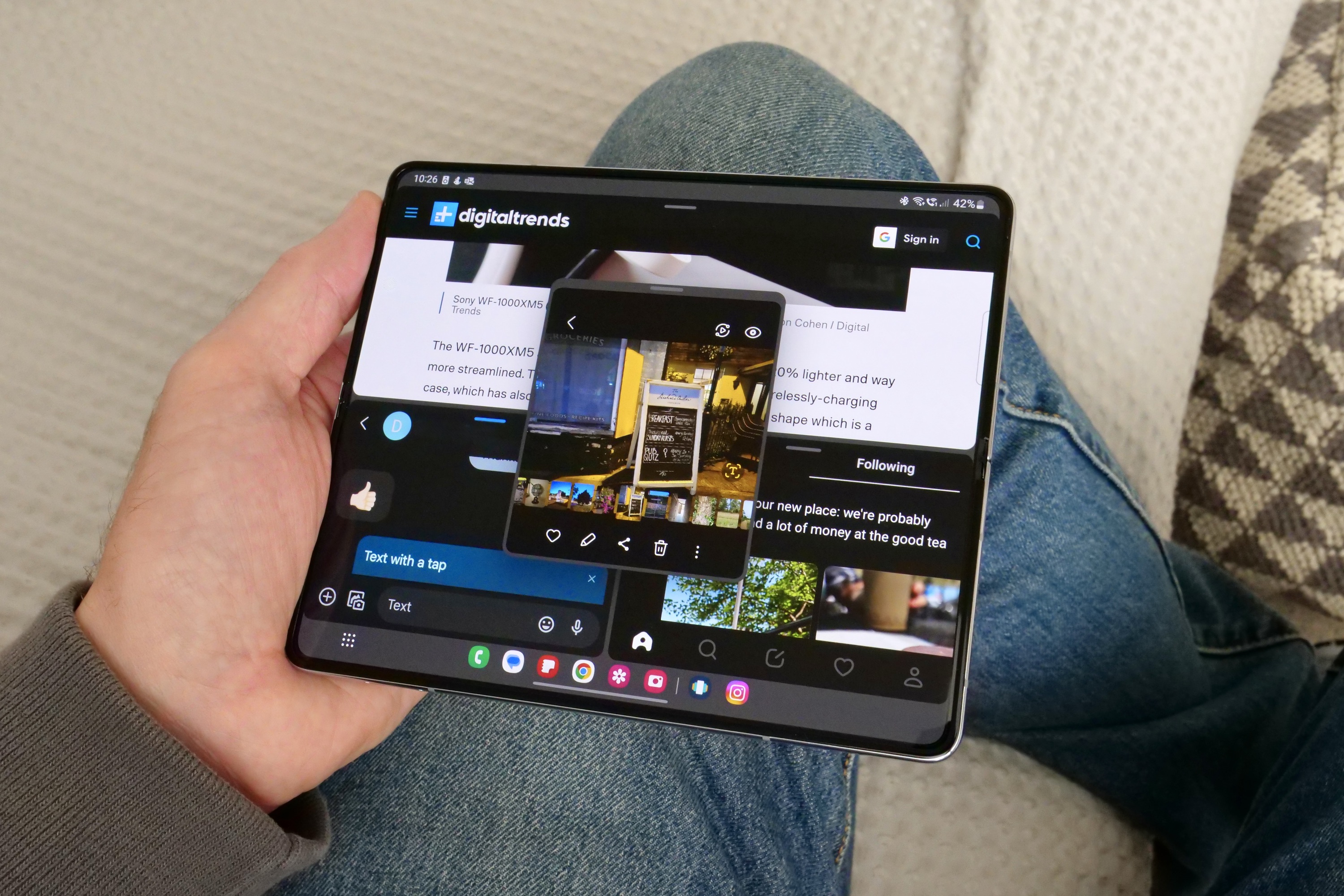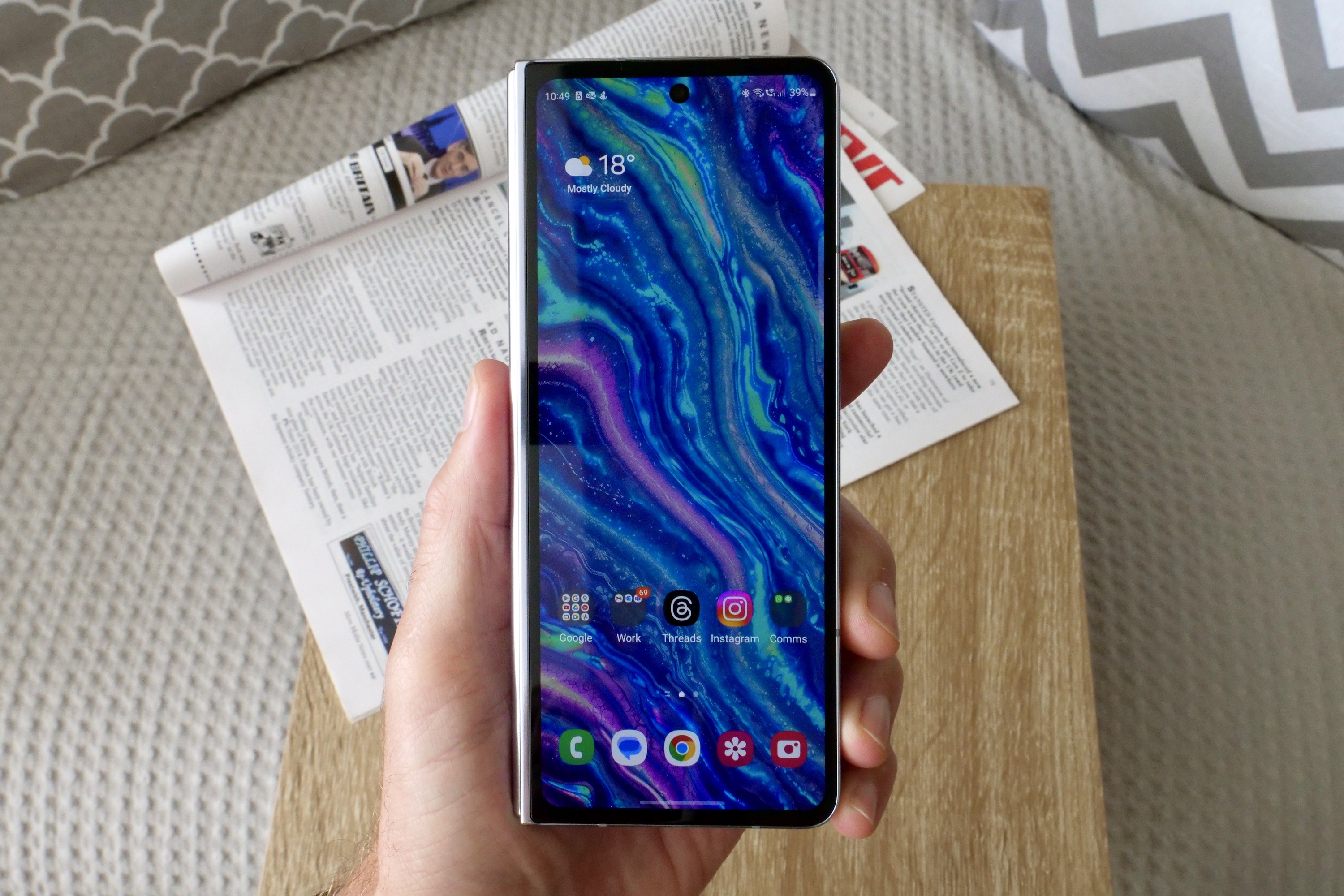
For years now, Samsung has been one of the dominant leaders in the foldable space. Whether you want a compact flip phone or a phone/tablet hybrid, Samsung’s Flip and Fold families have a lot to offer. For the latter, the Samsung Galaxy Z Fold 6 is the latest and greatest addition to the lineup.
If you’re in the market for a new foldable, then the Galaxy Z Fold 6 is definitely one to consider. But what if you already have a Galaxy Z Fold 5? Is it worth upgrading? Let’s take a closer look at both and see what is actually new and different.
Samsung Galaxy Z Fold 6 vs. Z Fold 5: specs
| Samsung Galaxy Z Fold 6 | Samsung Galaxy Z Fold 5 | |
| Size | 68.1 x 153.5 x 12.1mm (folded)
132.6 x 153.5 x 5.6mm (unfolded) |
67.1 x 154.9 x 13.4mm (folded)
129.9 x 154.9 x 6.1mm (unfolded) |
| Weight | 239 grams | 253 grams |
| Colors | Silver Shadow
Pink Navy Crafted Black (online exclusive) Purity White (online exclusive) |
Icy Blue
Cream Phantom Black Blue (online exclusive) Gray (online exclusive) |
| Price | Starts at $1,900 | Starts at $1,800 |
| Cover display | 6.3-inch HD+
Dynamic AMOLED 2X 2376 x 968 resolution with 22.1:9 aspect ratio at 410 ppi 120Hz refresh rate |
6.2-inch Dynamic AMOLED 2X
2316 x 904 resolution with 23.1:9 aspect ratio 120Hz refresh rate |
| Main display | 7.6-inch QXGA+
Dynamic AMOLED 2X Infinity Flex Display 2160 x 1856 resolution with 20.9:18 aspect ratio at 374 ppi 120Hz refresh rate 2,600 nits max brightness |
7.6-inch Foldable Dynamic AMOLED 2X
2176 x 1812 resolution at 373 ppi 120Hz refresh rate |
| Chipset | Qualcomm Snapdragon 8 Gen 3 for Galaxy | Qualcomm Snapdragon 8 Gen 2 for Galaxy |
| RAM | 12GB | 12GB |
| Storage | 256GB
512GB 1TB |
256GB
512GB 1TB |
| Rear cameras | 50MP main with DPAF, OIS, f/1.8
10MP telephoto with DPAF, OIS, f/2.4, 3x optical zoom 12MP ultrawide with f/2.2, 123-degree FOV |
50MP main with DPAF, OIS, f/1.8
10MP telephoto with DPAF, OIS, f/2.4, 3x optical zoom 12MP ultrawide with f/2.2, 123-degree FOV |
| Selfie cameras | 10MP with f/2.2 (cover display)
4MP with f/1.8 (inner under-display camera) |
10MP with f/2.2 (cover display)
4MP with f/1.8 (inner under-display camera) |
| Battery | 4,400mAh | 4,400mAh |
| Charging | 25W fast charging
15W wireless charging 4.5W reverse wireless charging |
25W fast charging
15W wireless charging 4.5W reverse wireless charging |
Samsung Galaxy Z Fold 6 vs. Z Fold 5: design

The Galaxy Z Fold 6 looks similar to its predecessor, with just a few minor adjustments to the overall design. Samsung refined the Galaxy Z Fold 6 to make it sleeker and more portable. It now has a perfectly symmetrical design with straight edges, similar to what you’ll find on the Galaxy S24 Ultra.
The Galaxy Z Fold 6 also uses a new dual-rail hinge structure, which is reinforced by the straightened folding edge. Thanks to this new hinge design, the Galaxy Z Fold 6 can better distribute shock from external impacts more evenly.
That’s no small upgrade. In our recent investigation, Samsung repair centers across multiple cities told us that up until the Galaxy Z Fold 4 generation, the hinge was notoriously fragile. Customers often came in with phones requiring an expensive replacement because the hinge parts somehow got misaligned even thought the device didn’t show any signs of physical damage.
When closed, the Galaxy Z Fold 6 measures 68.1mm by 153.5mm by 12.1mm. When unfolded, it’s 132.6mm by 153.5mm by 5.6mm. The overall weight is just 239 grams, making the Galaxy Z Fold 6 the slimmest and lightest Z Fold device ever.

For comparison, the Galaxy Z Fold 5 measures 154.9mm by 129.9mm by 6.1mm unfolded and 154.9mm by 67.1mm by 13.4mm when closed. It also weighs 253 grams. Although the Fold 5 was never outrageously heavy, the Z Fold 6 is considerably lighter and thinner. The changes Samsung has made to the Galaxy Z Fold 6’s exterior may also seem minor, but they have noticeably improved the comfort and ergonomics.
Notably, the Galaxy Z Fold 5 only offered an IPX8 level of ingress protection, which means no shielding against dust, but it could survive a 30-minute immersion in water for a depth of up to 1.5 meters. On the Galaxy Z Fold 6, we get IP48 shielding, which means aside from resilience against water, it can also block particles that are about 1 millimeter in size, or more. That’s not the best the industry has to offer, but given the fragile nature of foldable phones, we’ll gladly take whatever upgrades Samsung has to offer in order to make these expensive devices sturdier.
For the Galaxy Z Fold 6, you have three standard colors: Silver Shadow, Pink, and Navy. There are also two exclusive colors only available from Samsung’s website: Crafted Black (which has a textured back) and Purity White. These colors are a bit more interesting than what the Galaxy Z Fold 5 came in: Icy Blue, Cream, Phantom Black, or the exclusive blue or gray colors from Samsung’s website. If you ever wanted a pink foldable phone, then the Galaxy Z Fold 6 is the way to go.
Samsung Galaxy Z Fold 6 vs. Z Fold 5: displays

When it comes to a folding phone, one of the most important things to factor in is the display. The Galaxy Z Fold series is known for its tall and narrow cover display, which you probably either love or hate.
Samsung made some slight adjustments to the Galaxy Z Fold 6 by tweaking the aspect ratio for a more natural bar-type viewing experience. The 6.3-inch HD+ Dynamic AMOLED 2X cover display has a 2376 x 968-pixel resolution at 410 pixels per inch (ppi) and a dynamic refresh rate from 1hz to 120Hz.
The inner display of the Galaxy Z Fold 6 is a 7.6-inch QXGA+ Dynamic AMOLED 2X Infinity Flex display with a 2160 x 1856 resolution at 374 ppi. The refresh rate is between 1Hz and 120Hz. A crucial difference is that aside from the cover screen being slightly more pixel sense on the Galaxy Z Fold 6, it now also matches the inner panel’s 1-120Hz refresh rate range.
On the Galaxy Z Fold 5, it could only go as low as 48Hz. In a nutshell, you won’t feel any change in fluidity as your workflow moves from the cover screen to the inner foldable display on the Galaxy Z Fold 6. More importantly, the panels are also brighter. On the Galaxy Z Fold 5, both screens could only reach a peak brightness of 1,750 nites, while the Galaxy Z Fold 6 takes those numbers to 2,600 nits.

This time around, Samsung says it added enhanced layers on the inner display to help minimize the crease while maintaining the overall strength. The Galaxy Z Fold 6 also has enhanced Armor Aluminum, Corning Gorilla Glass Victus 2, and an IP48 water resistance rating, making it much more durable than its predecessor.
For comparison’s sake, the Galaxy Z Fold 5 had a 6.2-inch Dynamic AMOLED 2X cover display with 2316 x 904 resolution and up to a 120Hz refresh rate. The inner display was a 7.6-inch Foldable Dynamic AMOLED 2X with 1812 x 2176 resolution at 373 ppi and a refresh rate of up to 120Hz. It also had Corning Gorilla Glass Victus 2, but only an IPX8 rating.
Samsung Galaxy Z Fold 6 vs. Z Fold 5: cameras

Unfortunately, Samsung did not make any big changes to the camera system on the Galaxy Z Fold 6, which is pretty identical to its predecessor in terms of specs.
The rear has a triple-lens camera system. The 50-megapixel main camera has dual-pixel autofocus (DPAF), optical image stabilization (OIS) and an f/1.8 aperture. The ultrawide lens is 12MP and has an f/2.2 aperture and a 123-degree field of view (FOV). Lastly, the telephoto camera is 10MP and features OIS, DPAF, an aperture of f/2.4, and 3x optical zoom. The 12MP ultrawide camera is a new sensor, but otherwise, this is the same camera setup you’ll find on last year’s phone.
There are also two selfie cameras. The camera on the cover display is 10MP with f/2.2, and the under-display inner camera is a measly 4MP with f/1.8 aperture. Thankfully, since this is a foldable phone, you can use the rear cameras to take selfies because those aren’t terribly impressive selfie cameras. The inner display camera should work fine for video calls in a pinch, but it’s not the best.
If you were hoping for camera upgrades with the Galaxy Z Fold 6, then you’ll be quite disappointed. It’s not a bad setup by any means, but there also aren’t any major improvements compared to the Fold 5.
Samsung Galaxy Z Fold 6 vs. Z Fold 5: performance and battery

Since the Galaxy Z Fold is one of Samsung’s top-tier smartphones, it did not skimp on the hardware.
While the Galaxy Z Fold 5 has Qualcomm’s Snapdragon 8 Gen 2 for Galaxy chipset inside, the Galaxy Z Fold 6 has the newer Snapdragon 8 Gen 3 for Galaxy, which originally launched with the Galaxy S24 series. Both generations of foldables have 12GB RAM. Though both phones have plenty of power, the more recent processor in the Galaxy Z Fold 6 edges out that of its predecessor, but only slightly.
The newer chip also means that the Galaxy Z Fold 6 has a bit more processing power for all of the new Galaxy AI features, thanks to an NPU that is 42% faster compared to the unit on its predecessor. The raw CPU processing power has also received a 17% boost, while the GPU firepower has gone by 20% this time around.
Storage options for the Galaxy Z Fold 6 did not change from the Fold 5 either. You have three options: 256GB, 512GB, or 1TB.
Samsung did not increase the battery capacity for the Galaxy Z Fold 6, unfortunately. It still has the same 4,400mAh capacity as the Z Fold 5. Wired charging speeds are still 25 watts, so you can get about 50% charge in 30 minutes. The Galaxy Z Fold 6 also has 15W wireless charging and 4.5W reverse wireless charging — the same as the Z Fold 5.
Samsung Galaxy Z Fold 6 vs. Z Fold 5: software and updates

The Galaxy Z Fold 5 originally shipped with Android 13 and Samsung One UI 6.1. It’s slated to get four years of Android OS upgrades and five years of security updates. As such, the Z Fold 5 should get up to Android 17.
On the other hand, the Galaxy Z Fold 6 will ship with Android 14 and One UI 6.1.1 layered on top. As far as software support goes, Samsung began to offer seven years of Android OS upgrades and security updates with the Galaxy S24 line, so we should expect the same with the Galaxy Z Fold 6. That means the Galaxy Z Fold 6 should get software updates all the way to Android 21.
Both the Galaxy Z Fold 5 and Z Fold 6 have access to AI tools with the Galaxy AI suite. Some of these AI features include Circle to Search, Note Assist, Live Translate, and more. Galaxy AI features are also optimized for the larger displays of the Galaxy Z Fold series to make full use of their larger screens.
But do keep in mind that these AI features won’t be free forever. “Galaxy AI features will be provided for free until the end of 2025 on supported Samsung Galaxy devices,” says a Samsung support page. Samsung has plans to offer even more powerful features down the road, and it seems a subscription system for accessing these AI capabilities might be announced down the road.
Samsung Galaxy Z Fold 6 vs. Z Fold 5: should you upgrade?

This is a tough call. After all, while Samsung did make some nice changes to the Z Fold 6, it largely remains the same as its predecessor.
If you already have a Samsung Galaxy Z Fold 5, then you have to ask yourself if you are willing to drop at least $1,900 on a new phone that’s very similar to your current one. Sure, the Galaxy Z Fold 6 cover display is now more natural for viewing content, the device slimmer and lighter with a tweaked design, the hinge is more durable, and it even comes in pink! While those are very nice changes indeed, the Z Fold 6 really isn’t all that different from the Z Fold 5.
But if you don’t already have the Galaxy Z Fold 5, then the Galaxy Z Fold 6 is a worthy foldable to consider. We really liked the Fold 5 last year, and from what we’ve seen so far, the Fold 6 is a practically meaningful iterative successor. That’s a recipe for success if we’ve ever heard one, even if it means the Fold 6 isn’t a particularly exciting upgrade for existing Fold 5 users.
What you should also keep in mind is the sheer pace of innovation, the long-term durability of a foldable phone, and the shifting consumer behavior when it comes to smartphones. Both devices will get official software support for at least half a decade, but will you stick with one for that long? That consideration is important owing to the amount of money you are spending on a Samsung foldable.
If you can get a seriously good exchange offer on an existing Galaxy Z Fold 5 and the added cost won’t be a fat pinch to your wallet, the Galaxy Z Fold 6 will certainly feel like a breath of fresh air. Otherwise, the Galaxy Z Fold 5 is still a perfectly fine phone that won’t underwhelm your expectations.




